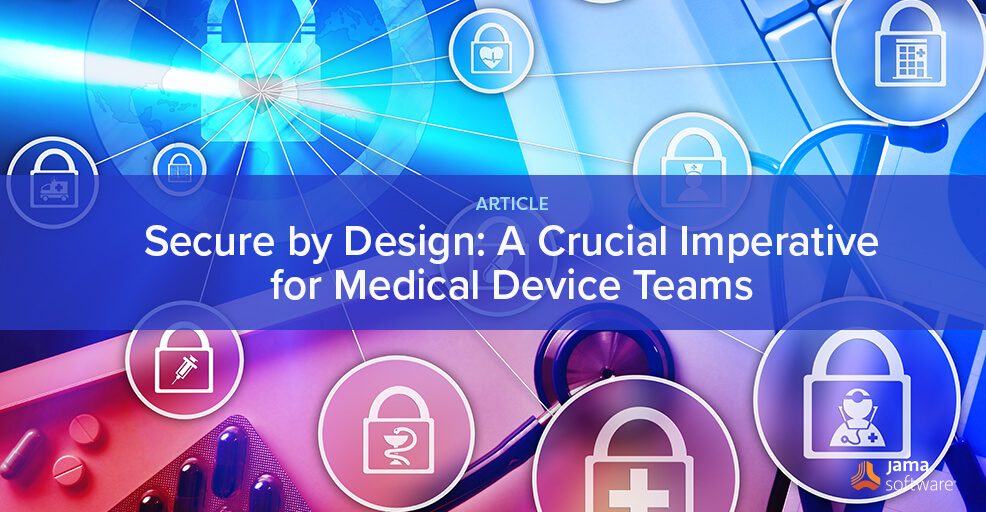
Secure by Design: A Crucial Imperative for Medical Device Teams
In today’s healthcare landscape, technology plays a crucial role in patient care. Medical devices have become essential for monitoring vital signs and administering treatments. However, as these devices become more connected and complex, ensuring their security is now more important than ever. This is where the concept of “Secure by Design” comes in, serving as a fundamental principle for medical device teams to navigate the intricate world of healthcare technology. Which begs the question, with the rise in security concerns, do regulations now need to consider whether each device is safe, effective, and secure?
Understanding the Landscape
Medical devices have advanced beyond being simple, independent systems. With the rise of the Internet of Things (IoT), devices are now interconnected, allowing for the exchange of data. While this connectivity has many advantages, it also opens vulnerabilities that could be exploited by malicious entities.
Cybersecurity threats not only put patient data at risk, but also the health of those who rely on these devices. It’s also a costly and time-consuming process for medical device companies to manage, and resolve. According to IBM Security analysis of research data compiled by Ponemon Institute, 83% of organizations have had more than one security breach, and the average cost of each breach averaged $4.3 million globally. That number more than doubles for the average cost of a security breach in the United States – $9.44 million – the highest in the world.
RELATED: Traceable Agile™ – Speed AND Quality Are Possible for Software Factories in Safety-critical Industries
The Essence of Secure by Design
Secure by Design is a proactive approach that prioritizes security in the development process. Rather than treating security as an afterthought, it is integrated into the design and development phases. For medical device teams, this means implementing security measures from the start of a project, considering potential threats and vulnerabilities, and implementing safeguards to reduce risks.
Key Principles of Secure by Design:
- Risk Assessment: Before beginning development, medical device teams must conduct a thorough risk assessment. This involves identifying potential threats, understanding vulnerabilities, and evaluating the potential impact of security breaches on patients and healthcare providers.
- Data Encryption: Due to the sensitive nature of healthcare data, encryption is a crucial aspect of secure design. Implementing strong encryption protocols ensures that patient information remains confidential and secure during transmission and storage.
- Access Control: Limiting access to medical devices is crucial. Secure by Design stresses the importance of implementing strict access controls, ensuring that only authorized personnel can interact with the device. This prevents unauthorized users from tampering with critical settings or accessing sensitive patient data.
- Regular Software Updates: Vulnerabilities in software can leave devices vulnerable to cyber threats. It is essential for medical device teams to prioritize regular software updates and patches to address potential security risks. This ensures that devices can withstand evolving cyber threats.
- User Education: Even the most secure devices can be compromised if users are not vigilant. Secure by Design also includes educating end-users on cybersecurity best practices. This ensures that individuals using medical devices are aware of potential risks and take necessary precautions.
Regulatory Landscape and Compliance
The healthcare industry must comply with strict regulations to protect the well-being of patients. Regulatory agencies, such as the Food and Drug Administration (FDA), acknowledge the significance of cybersecurity in medical devices. Following regulatory guidelines is not only a legal obligation, but also a dedication to ensuring the utmost safety and security for patients.
Challenges and Solutions
Implementing Secure by Design in the development of medical devices can be challenging. Balancing the need for innovation with strict security measures is complex. Additionally, the ever-changing landscape of cybersecurity threats requires constant attention.
Solutions:
- Collaboration and Training: It is crucial to foster collaboration between cybersecurity experts and medical device developers. Ongoing training for the development team ensures they are informed about the latest security threats and mitigation strategies.
- Third-Party Security Assessment: Engaging third-party security experts to regularly assess medical devices can provide an unbiased perspective on their security. This external validation can uncover blind spots that internal teams may miss.
- Incident Response Planning: Despite preventative measures, security incidents can still occur. A robust incident response plan allows medical device teams to promptly and effectively address breaches, minimizing their impact on patients and healthcare providers.
RELATED: The Complete Guide to ISO 13485 for Medical Devices
The Future of Medical Device Security
As technology continues to advance, the healthcare industry is constantly evolving. Medical device teams must be proactive in anticipating and addressing potential security challenges to stay ahead of the curve. Secure by Design is not a one-time effort, but an ongoing commitment to the safety and well-being of patients.
It is not just best practice, but a moral imperative for medical device teams to integrate security into the DNA of their development process. By doing so, they contribute to a safer and more resilient healthcare ecosystem. The future of healthcare relies on innovation, connectivity, and security, and it is the responsibility of medical device teams to ensure that these pillars remain strong.
Jama Connect® for Medical Device Development
Jama Connect for Medical Device Development helps medical device teams reduce the effort required to achieve regulatory compliance throughout the development process. With this solution, medical device teams can manage design controls for device requirements and related risks, simplifying regulatory submissions and audit preparations while accelerating time to market. Learn more: Solution Overview: Jama Connect Solution for Medical Device Development
Note: This article was drafted with the aid of AI. Additional content, edits for accuracy, and industry expertise by [Vincent Balgos, McKenzie Jonsson, and Decoteau Wilkerson].
- Navigating AI Safety with ISO 8800 in Road Vehicles - August 7, 2025
- Automotive Industry Signs Memorandum of Understanding - July 15, 2025
- Construction’s Next Leap: AI as a Strategic Partner - June 26, 2025